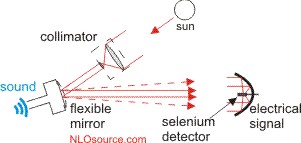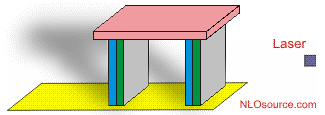| |
|

The Nonlinear Optics Web Site
History of Photomechanics
Alexander Graham Bell's Photo PhoneOur modern era of scientific and technological progress has brought us a high-speed internet, nuclear medicine for non-invasive diagnostics, computers that make our lives easier, and genetic engineering that has yielded better crops and designer therapies for all sorts of diseases. Many technologies that we associate with modern times had taken root more than a century ago. Using the crude tools available to him in the late 1800s, Alexander Graham Bell is believed to have been the first to observe and use photomechanical effects.
The Figure above shows a photophone. Light is reflected from a flexible membrane that is set in motion by sound. The reflected light is deflected by the vibrating membrane and detected by a photocell. The photocell converts the light into an electrical signal that drives a speaker. In this demonstration, Bell intelligibly transmitted his voice over a couple of city blocks on a beam of light - an impressive feat given the crude instruments available at the time. The above figure shows a collimated beam of light whose intensity is modulated into pulses by a spinning plate with holes, called a chopper. The blinking light then hits the photomechanical material. The pitch of the sound emitted from the sample increases as the speed of the chopper is increased. Bell found that sound can be perceived from light pulses that directly hit the human eardrum. While Bell's work with the telephone lead to the highly successful Bell Telephone Company, photomechanical effects remained a laboratory curiosity with no technological implications aside from the technology's use for eavesdropping by reflecting light from a window pane. Electrostriction and the Uchino WalkerA photostrictive material changes length in response to light. Photostriction is a two step process. First, the light releases charges in the material. The electric field due to these charges leads to a change in the shape of the material through the piezoelectric effect.
[1] For a more detailed history, see: M. G. Kuzyk, Polymer Fiber Optics: Materials, Physics, and Applications, CRC Press, Taylor & Francis Group, Boca Raton (2007). |
A bimetalic strip, made from two sheets of dissimilar metal will bend as a function of temperature due to the differing amount of thermal expansion. In analogy, Uchino used two sheets of ceramic materials, one that is photostrictive and the other, which is not. When exposed to light, the photostrictive sheet expands and causes the layered structure to bend.
Using such layered structures as legs, Uchino made a little machine that walks when its legs are illuminated with light pulses. The figure above illustrates the approximate design of such a walker. The Importance of Photomechanical EffectsAll of modern technology is based on 5 electronic devices: Wires, which transmit information from one place to another; sensors, which convert some physical property such as temperature or stress into an electrical signal; transistors; which can be used to perform logic and control the flow of electricity; actuators, which convert electrical energy into mechanical energy - such as motors; and powers supplies, which provide electrical power. The table above summarizes the five electrical device classes and the analogous optical technologies. The blue shaded areas represent mature technologies such as lasers, which are found in many commercial products like checkout scanners and DVD players; optical fibers that carry huge amounts of information across the oceans and between high-speed computers; and optical sensors that are capable of measuring small variations in pressure and temperature. Much of the field of nonlinear optics has focused on developing the optical equivalent of the transistor (green shaded region above). An optical transistor would control the flow of light as a transistor controls the flow of electricity. Intense research over the last two decades is finally coming to fruition with the introduction of commercial electrooptic devices. Photomechanical effects are the missing ingredient for making all-optical technologies possible. Since light allows for the design of novel new architectures, and does not suffer some of the drawbacks associated with electronics, the development of photomechanical effects would provide the basis of amazing new technologies. |
| <<back to introduction to photomechanical effects | more on all-optical technologies>> |

